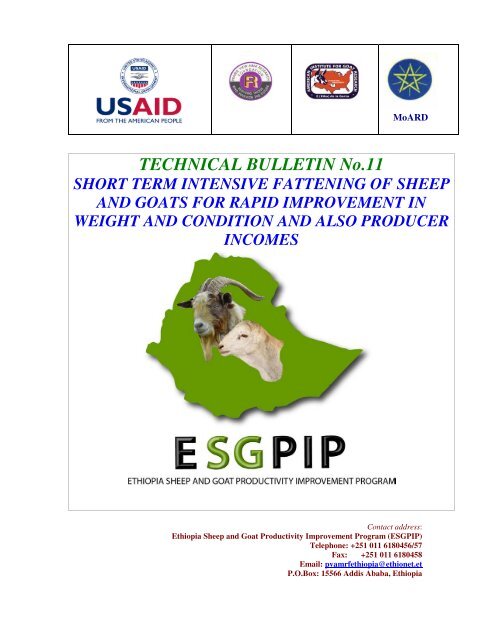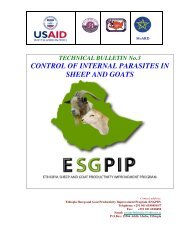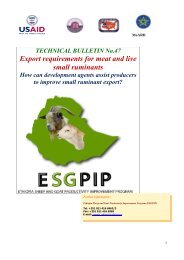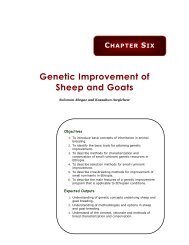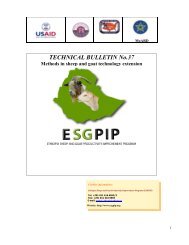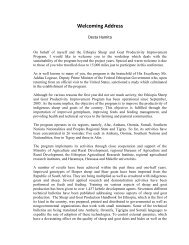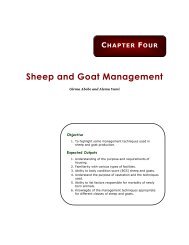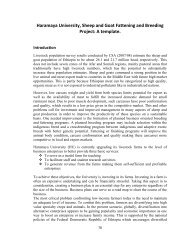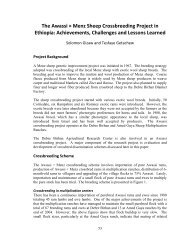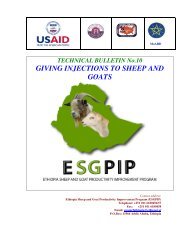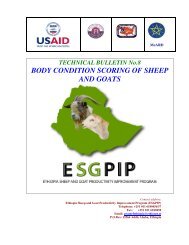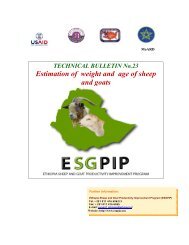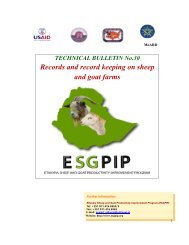TECHNICAL BULLETIN No.11 - esgpip
TECHNICAL BULLETIN No.11 - esgpip
TECHNICAL BULLETIN No.11 - esgpip
Create successful ePaper yourself
Turn your PDF publications into a flip-book with our unique Google optimized e-Paper software.
MoARD<br />
<strong>TECHNICAL</strong> <strong>BULLETIN</strong> <strong>No.11</strong><br />
SHORT TERM INTENSIVE FATTENING OF SHEEP<br />
AND GOATS FOR RAPID IMPROVEMENT IN<br />
WEIGHT AND CONDITION AND ALSO PRODUCER<br />
INCOMES<br />
Contact address:<br />
Ethiopia Sheep and Goat Productivity Improvement Program (ESGPIP)<br />
Telephone: +251 011 6180456/57<br />
Fax: +251 011 6180458<br />
Email: pvamrfethiopia@ethionet.et<br />
P.O.Box: 15566 Addis Ababa, Ethiopia
FOREWORD<br />
This Technical Bulletin titled “Short term intensive fattening of sheep and goats before<br />
slaughter for rapid improvement in weight and condition and also producer incomes ” is<br />
the eleventh in a series produced by the Ethiopia Sheep and Goat Productivity<br />
Improvement Program (ESGPIP). The ESGPIP is a USAID-funded Project with the<br />
objective of improving the productivity of Ethiopia’s sheep and goats.<br />
The Technical Bulletin is intended to serve as an extension aid for Kebele Development<br />
Agents (KDA’s) to foster short term intensive fattening by farmers and other producers in<br />
ESGPIP target weredas and beyond. Attempt is made to include all information needed<br />
for intensive fattening operations in the form of a package. It is believed that the<br />
information contained in this technical Bulletin will be transferred to sheep and goat<br />
producers and help them to improve their livelihoods. The information will also be useful<br />
for other users engaged in the production of other types of ruminants.<br />
At this juncture, I would like to thank all those involved in the preparation and review of<br />
this Technical Bulletin.<br />
Desta Hamito (Prof.)<br />
Chief of Party<br />
ESGPIP<br />
i
TABLE OF CONTENTS<br />
FOREWORD...................................................................................................................... i<br />
TABLE OF CONTENTS ................................................................................................. ii<br />
1. Introduction................................................................................................................... 1<br />
2. Definition of terms .................................................................................................... 1<br />
3. Advantages of fattening............................................................................................ 2<br />
4. Fattening systems...................................................................................................... 2<br />
5. How to fatten sheep and goats ................................................................................. 3<br />
5.1. Selection of sheep and goats for fattening ............................................................... 3<br />
5.2. Management of finishing sheep and goats............................................................... 4<br />
5.3. Health of fattening sheep and goats......................................................................... 5<br />
5.4. Feeding finishing sheep and goats ........................................................................... 7<br />
5.5. Planning rounds of fattening.................................................................................... 8<br />
6. Record keeping.......................................................................................................... 9<br />
7. Profit of the fattening operation .............................................................................. 9<br />
ii
Short term intensive fattening of sheep and goats before slaughter for<br />
rapid improvement in weight and condition and also producer incomes<br />
Prepared by: Alemu Yami Edited by: R.C. Merkel<br />
1. Introduction<br />
Current carcass yields of Ethiopian sheep and goats average 42%. Improving carcass yield<br />
results in more meat available for domestic consumption/export and directly increases<br />
producer incomes. Short term intensive feeding using locally available feedstuffs is a<br />
strategy that can be employed to increase animal live weights and subsequent carcass<br />
yields. Short-term intensive feeding prior to sale is economically more feasible than the<br />
current systems where animals are kept for long periods of time on maintenance level<br />
feeding. Cost benefit analyses of short term fattening compared to maintenance feeding for<br />
extended periods show that short term fattening can be a viable business venture.<br />
The domestic market remains to be the largest consumer of Sheep and goats in Ethiopia<br />
even though exports have been increasing over the past years. A fattening operation can be<br />
of various sizes. One can fatten one sheep or goat up to many hundreds or even thousands<br />
depending upon availability of capital, market access, etc. operations ranging from<br />
backyard to large scale fattening should be promoted. This can be done through provision<br />
of training, credit, fostering market access, etc.<br />
Fattening/Finishing involves intensive feeding of sheep and goats to slaughter weight with<br />
adequate finish (fat deposit) in feedlots. This targets the local market that has high demand<br />
for fat animals. The operation of large feedlots by export slaughter houses and independent<br />
feedlot operators (on-farm feedlots) is becoming feasible. The principal functions of such<br />
feedlot operations are to assemble large numbers of sheep and goats, often coming from<br />
different genetic and management backgrounds, and produce a product of acceptable<br />
standard. The following guidelines will serve these operations and also small farmers that<br />
want to fatten smaller numbers of sheep and goats. This will be the subject of this particular<br />
technical bulletin.<br />
2. Definition of terms<br />
• Feedlots: Enterprise in which animals are fed grain and other concentrates for<br />
usually 90-120 days to gain adequate muscle and finish (fat deposit) for slaughter.<br />
• Dry lot: Confined area in which animals are kept and fed intensively.<br />
• Fattening (finishing): Intensive feeding of highly nutritious feed to promote fast<br />
growth and fat deposition to achieve desired carcass quality.<br />
• Finished: Sheep and goats that have been fattened and are ready for slaughter.<br />
• Free-choice (ad libitum) feeding: Animals are given unlimited access to the feed<br />
and consume as much as they can.<br />
1
• Hand-fed: Method of feeding animals at regular intervals, allowing them to clean<br />
up the feed before they are fed again.<br />
3. Advantages of fattening<br />
Fattening is a strategic feeding option that can have the following advantages under<br />
Ethiopian conditions:<br />
• Technically, it is quite simple and within the capabilities of small farmers to<br />
implement; moreover, the results are highly visible. This helps farmers to have<br />
confidence in the technique. Other techniques such as feeding to boost reproductive<br />
performance are less convincing because the farmer may be unsure that the extra feed<br />
resulted in any benefit.<br />
• Benefits can be realized within a short period of time unlike other animal production<br />
activities.<br />
• Fattening generates cash income that is eagerly sought by farmers.<br />
• Fattening is generally profitable because the value per kilogram of live weight<br />
increases as both weight and condition increase.<br />
4. Fattening systems<br />
Intensive feeding of sheep and goats before slaughter in Ethiopia can be categorized into<br />
two systems:<br />
• Traditional systems: This system generally depends on grazing natural or planted<br />
pastures with variable degrees of supplementation. Animals require a long period of<br />
time to attain market weight and condition. It is also associated with huge<br />
fluctuations in the weights and conditions of the animals depending on feed<br />
availability. This system can be improved to supply animals of acceptable condition<br />
to slaughterhouses for ultimate export. The conditioned animals may also go into a<br />
finishing operation targeted to supply the local market. Several improved traditional<br />
systems are in use, but they are not widespread. For example, systems of sheep<br />
fattening exist in the Adillo area of the southern region where conditioned animals<br />
are fattened by feeding sweet potatoes and other high value ingredients. These<br />
fattened animals fetch very high prices. Conditioning sheep and goats for supply to<br />
slaughterhouses for ultimate export will be a subject of another technical bulletin.<br />
2
Feeding sugar beet to finishing<br />
lambs<br />
Adillo sheep nearing completion<br />
of the fattening period<br />
Figure 1. Traditional fattening in the Adillo area.<br />
Fattened sheep being marketed<br />
• Agro-industrial byproduct based fattening: Fattening of sheep based on agroindustrial<br />
byproducts is also practiced in areas such as the Adama area. This system<br />
can be promoted to similar areas where agro-industrial byproducts are available.<br />
Fattening using agro-industrial byproducts like sugar processing byproducts is<br />
feasible in places for instance in parts of Wellega where valuable feed resources<br />
such as molasses (from the Finchaa sugar factory) and corn (grain and residue) are<br />
widely available. Protein sources like oilseed cakes can be purchased from nearby<br />
processing plants and/or forage legumes can be grown in the area. Brewery<br />
byproducts are also available from the Bedele brewery to serve as protein sources.<br />
The Horro sheep breed, one of the fast growing and large breeds in Ethiopia, is also<br />
indigenous to this area.<br />
The following table shows examples of rations where byproducts form the feed base.<br />
Local equivalents of the weights indicated can be used whenever scales are not<br />
available.<br />
Table 1. Molasses based rations<br />
Ingredient Ration I Ration II Ration III<br />
Straw Ad lib Ad lib Ad lib<br />
Molasses 350 g 250 g 200g<br />
Oilseed cake 125g 100 g ---<br />
Brewers dried grain --- --- 200 g<br />
Urea 10 g --- ---<br />
Molasses urea block ---- Free choice Free choice<br />
5. How to fatten sheep and goats<br />
5.1. Selection of sheep and goats for fattening<br />
Consider the following when selecting sheep and goats for intensive fattening:<br />
3
• Condition: Select animals that are healthy and have no visible physical defects.<br />
Avoid emaciated animals as their poor condition may not entirely be due to<br />
nutritional factors. Emaciated animals often take a long time to recover. Target<br />
animals with medium body condition Body condition scores of 2.25-3.0).<br />
• Skeletal frame: The animals should have a large skeletal frame and good body<br />
condition.<br />
• Castration: Castration influences the fattening process. Castrated animals deposit<br />
more fat while uncastrated animals have more muscular growth. The selection of<br />
castrated or uncastrated animals depends on the final product desired and market<br />
conditions. Castrated sheep and goats have a higher demand in the local market<br />
especially during the holidays.<br />
• Breed: Identify breeds with greatest potential for growth and fattening. Early<br />
maturing breeds start depositing fat at an earlier age and can be ready for market at<br />
a lower weight. They need a shorter feeding period to reach a good carcass finish<br />
although their growth rates are relatively lower. Late maturing types can reach<br />
market readiness at a higher weight. In general, lowland animals mature late<br />
compared with highland animals. Hence, lowland animals are preferred for the<br />
production of fattened animals at a higher weight.<br />
• Sex: Females are earlier maturing than males. Males can do well in feedlots, but<br />
often cause problems by fighting. Females can do well in feedlots, but often have<br />
lower growth rates partly because they reach carcass finish at an earlier age.<br />
• Weight of animals: Weight of animals at the start of the feeding operation governs<br />
the duration of feeding and the types and amounts of feedstuffs needed. Lightweight<br />
(15-20 kg) animals can use more roughage, whereas heavier lambs (>25 kg) require<br />
more concentrates and a shorter feeding period. Light weight sheep and goats are<br />
more desirable for conditioning based on a larger proportion of roughage, whereas<br />
heavier animals perform best where high concentrate diets are used. It is therefore<br />
best to use sheep and goats with weights ranging from 20-25 Kg for the fattening<br />
operation to take advantage of the two situations.<br />
• Age: Animals can be placed on intensive feeding at any age, usually after weaning.<br />
Avoid animals that are too old. Check that the teeth are sound. This has<br />
implications on feed utilization. It is advisable to select sheep/goats between 2 and<br />
4years of age for fattening;<br />
5.2. Management of finishing sheep and goats<br />
• The fattening program should be started after the necessary feed supplies are<br />
secured. Underfeeding and incorrect timing are the most common causes of failures<br />
in fattening activities.<br />
• The objective in a fattening operation is to convert as much of the feed to body<br />
tissue as possible. It is, thus, necessary to minimize the movement of animals<br />
during the fattening period. They should be allowed only limited exercise.<br />
• The success of a finishing operation depends on the first two weeks after arrival of<br />
animals. They may have traveled long distances and will be stressed, hungry, and<br />
thirsty. They are generally gathered, sorted; often stand for a long time without feed<br />
4
and water. It is recommended that the following guidelines be followed under such<br />
circumstances:<br />
o Rest the animals for a few hours in a dry, clean, sheltered area with access to<br />
fresh water after arrival. Then offer grass hay or mixed grass-legume hay.<br />
o Hand feed salt during the first two weeks; then provide trace mineral salt in<br />
a separate feeder. Afterwards, these supplements can be mixed in the<br />
complete diet, but salt should continue to be provided ad libitum (free<br />
choice).<br />
• Animals should have feed available at all times including evenings. If there is no<br />
feed left in the morning, feed supply should be increased for the following day.<br />
• Adjust the animals to the fattening concentrate diet over a two week period by<br />
feeding the concentrate after the animals have consumed enough roughage to<br />
provide bulk. Gradually increase the intake of the concentrate every two days, while<br />
providing free access to the basal roughage diet.<br />
• Sort the animals by weight/size/sex and feed in uniform weight/sex groups. Large<br />
animals tend to bully smaller animals and keep them away from feed troughs.<br />
• Cull non-performing animals. Some animals do not adapt to intensive feeding<br />
irrespective of breed, sex or age. It is best to cull these animals as soon as possible.<br />
They can be identified by their poor performance in the initial stages of feeding.<br />
• Feed for 90 to 120 days. The length of the feeding period depends upon the desired<br />
animal condition and the type of ration fed. What is desired for the export market<br />
may just be conditioning without the amount of fat desired by the local market.<br />
Thus, animals for export can be sold at a time when the desired condition is<br />
attained.<br />
• Water should be available at all times. Inadequate water supply will affect their<br />
performance.<br />
• The animals should have shelters that protect them from adverse environments. The<br />
shelter need not be expensive. Any building material will do, depending on<br />
availability and financing. The shelter can be constructed from locally available<br />
materials such as bamboo or mud with thatched roof. Space required is about 2 m 2<br />
per animal. Shelter should normally be open on one side. Walls up to 1.2 meters on<br />
the other three, with a gap of 0.5-0.8 meters between the walls and roof, to provide<br />
sufficient ventilation without draft. Muddy feedlots reduce feed efficiency<br />
drastically; it is thus necessary to keep the premises dry. Flooring should be<br />
included and elevated at least about 15 degrees to facilitate cleaning and drainage.<br />
Feeding racks (silage, water, mineral and concentrate) should be accessible to both<br />
goats and caretaker, preferably in the front of the aisle. A feeding space of 20 linear<br />
centimeters should be provided per animal.<br />
• Socio-economic considerations: Sheep and goats for fattening need to be purchased<br />
when prices are low and sold at times of peak demand when prices are high. Feeds<br />
should also be purchased when prices are lowest and stored. These measures are<br />
important in increasing the profit margin of the fattening operation.<br />
5.3. Health of fattening sheep and goats<br />
5
It is best to use own animals for the fattening operation if available. The second option is<br />
purchasing from the immediate village. Purchase from the market should be taken as the<br />
last option. The incidence of especially pestes des petits ruminants (PPR) is rampant in<br />
many areas whenever sheep and goats from different sources are gathered in the local<br />
markets. Newly purchased animals should be watched closely. If there are signs of disease,<br />
such animals should be separated from the rest of the flock. If the disease persists, the<br />
animals should be disposed off.<br />
Feeding and watering facilities and sheds should always be clean. Vaccination and parasite<br />
control programs should be followed.<br />
Drench for internal parasites and treat for external parasites with broad spectrum<br />
anthelmintics and acaricides respectively before the start of the feeding operation. This will<br />
improve feed utilization and performance. The following vaccinations need to be given<br />
depending upon the agro-ecology of the area. The vaccinations have to be carried out<br />
immediately after arrival of the animals at the fattening site.<br />
Agro-ecological zone Prevalent diseases<br />
Highland<br />
Anthrax<br />
Pasteurellosis<br />
Sheep and goat pox<br />
Mid altitude<br />
Peste des Petits Ruminants (PPR)<br />
Sheep and goat pox<br />
Anthrax<br />
Pasteurellosis<br />
Lowland<br />
Peste des Petits Ruminants (PPR)<br />
Anthrax<br />
Pasteurellosis<br />
Contagious Caprine Pleuro-Pneumonia (CCPP)<br />
Watch for signs of acidosis and Urinary calculi (especially in males goats). These are<br />
conditions that can appear in intensive fattening where high levels of concentrates are used.<br />
The following are the signs to watch and measures to take in case the conditions appear:<br />
• Acidosis: Signs appear from 10-36 hours after dietary changes. Depression, loss of<br />
appetite, abdominal distention causing pain and discomfort. Diarrhea develops.<br />
Rapid respiration and pulse, incoordination, weakness, coma, and death. Avoid<br />
sudden dietary changes. Treatment generally un-satisfactory. Early cases may<br />
respond to high antibiotic levels given orally to reduce population of acid-forming<br />
bacteria, (Acidosis) indigestion may be treated with anti- acids like baking soda<br />
(sodium bicarbonate), magnesium carbonate or magnesium hydroxide given orally<br />
in warm water ( 1 gm/kg body weight) to neutralize rumen acidity.<br />
• Urinary calculi: a common metabolic disease of male sheep and goats fed rations<br />
with high phosphorus levels. Grain products tend to be very high in phosphorus<br />
relative to calcium, whereas forages have a better ratio. The disease occurs when<br />
calculi (stones), usually comprised of phosphate salts, lodge in the urinary tract and<br />
6
prevent urination. Affected animals usually start with restlessness and usually<br />
experience a loss of appetite. May experience abdominal pain, urine dribbling, kick<br />
at their belly and strain to urinate. They may have a humped-up appearance and<br />
edema under their belly. Urinary calculi can be prevented by feeding rations which<br />
contain a calcium-to-phosphorus ratio of at least 2:1. The ratio of Ca:P should never<br />
be allowed to go below 1:1. It is also important that animals have an ample supply<br />
of clean water. The addition of salt to the ration will increase water intake and<br />
decrease stone formation.<br />
5.4. Feeding finishing sheep and goats<br />
Finishing can be accomplished with rations containing different proportions of roughages<br />
and concentrates. The proportion depends on the type of feeds available, the desired length<br />
of feeding and the types of animals to be finished. Higher proportions of concentrate<br />
feeding shorten the time required for fattening.<br />
• Concentrates:<br />
o High-energy concentrates are fed for energy. Grains and grain products<br />
commonly fed are shelled corn, sorghum, oats and wheat. Liquid feedstuffs,<br />
such as molasses, can also be used as a source of dietary energy. Alternative<br />
energy sources, such as fodder beet and sweet potato can be fed to growing<br />
and finishing sheep and goats, but in most situations performance will not<br />
equal that obtained from grains and grain byproducts. The use of these<br />
feeds depends on the price differential in utilizing them for fattening<br />
compared to other alternative uses.<br />
o High-protein concentrate sources most commonly fed are noug seed cake,<br />
cottonseed cake, linseed cake, sunflower cake, brewer’s grains, distiller’s<br />
grains and other similar feeds.<br />
• Roughages:<br />
o A wide variety of roughages can be fed to growing and finishing lambs. The<br />
amount of roughage to feed depends on the objective of feeding the<br />
roughage. The roughage may be added to simply add bulk or contribute to<br />
the feeding value. The role of roughage in short term intensive feeding is<br />
generally to provide bulk.<br />
The rations used for fattening can be classified into three categories: starter, intermediate<br />
and finishing.<br />
• Starter: contains higher levels of roughage, 14% crude protein. The ration is<br />
hand-fed in order to control feed consumption and identify any sick animals or<br />
animals going off-feed. This ration is generally fed for one week. For animals that<br />
have been transported long distances, it is advisable to increase this phase to two<br />
weeks.<br />
• Intermediate: The animals are gradually changed to the intermediate ration<br />
containing a lower proportion of roughage to the total ration, 13% crude protein. Is<br />
hand-fed for one week.<br />
7
• Finishing ration: Animals are gradually changed from the intermediate to the<br />
finishing ration, which contains even less roughage, with protein content initially<br />
of 13%, declining to 12% when successful adjustment on the rations has been<br />
achieved. Finishing rations are self-fed. The finishing ration should contain about<br />
10% roughage which is fed in a separate feeding trough, concentrates being selffed.<br />
Heavy lambs must be finished more rapidly with a high concentrate ration,<br />
while lighter lambs can be fed rations containing more roughage.<br />
Table 2. Sample feeding programs for finishing sheep and goats in feed lot<br />
Ingredient<br />
Diet I (%) Diet II (%) Diet III (%)<br />
Weight (kg) Weight (kg) Weight (kg)<br />
To 30 30-40 40 to<br />
market<br />
To 30 30-40 40 to<br />
market<br />
To 30 30-40 40 to<br />
market<br />
Ground corn 52 62 72 49 59 69 60.5 60.5 59.5<br />
Ground corn cobs 20 10 - -- -- -- -- -- --<br />
Chopped grass hay 33 23 13 -- -- --<br />
Oilseed cake 11 11 11 11 11 11 10 10 11<br />
Dried legume hay 10 10 10 -- -- -- 23 23 23<br />
Liquid molasses 5 5 5 5 5 5 5 5 5<br />
Dicalcium phosphate 1 1 1 1 1 1 1 1 1<br />
Trace mineral salt 1 1 1 1 1 1 1.5 1.5 1.5<br />
Figure 2. Goats in a short term fattening scheme by farmers in the Adami Tulu area<br />
supported by the ESGPIP.<br />
5.5. Planning rounds of fattening<br />
A producer can plan to fatten three rounds of sheep and/or goats in a year. The completion<br />
of each round should be planned in such a way that it coincide with public holidays when<br />
the sale prices of fattened sheep and goats is highest. One can plan for three rounds of<br />
fattening in a year with duration of 90 days for each round. The remaining period between<br />
8
the subsequent rounds is required for making preparations of inputs and also for cleaning<br />
and disinfection of the premises.<br />
6. Record keeping<br />
On farm records are essential in evaluating and improving the performance of a fattening<br />
operation and make improvements based on facts. The format should be simple and readily<br />
understood. Development Agents should make a sample record book that can be shown to<br />
farmers. This record book should be in a language understood by the producers.<br />
Some of the records listed below may need to be kept. The value and relevance of the<br />
different types of records will vary with differing sheep and goat production systems.<br />
• Growth or weight records kept periodically by recording the body weight of<br />
animals.<br />
• Health records including morbidity, symptoms, mortality and diagnosis, treatments,<br />
etc.<br />
• Feed consumption: the amount of concentrate fed should be recorded to calculate<br />
profitability.<br />
• Financial records: All Expenses and receipts of each round of the fattening<br />
operation need to be recorded. This is essential to calculate profitability. An<br />
example of a simple financial record used to calculate profitability is shown in<br />
Table 1.<br />
7. Profit of the fattening operation<br />
Feedlot operators need to keep a close watch on feedlot profit, which is a very sensitive<br />
measure of the efficiency of management. The factors affecting profit in a feedlot include:<br />
• The number of days spent in the feedlot, which is related to the initial weight of the<br />
animal on entering the feedlot and the growth rate of the animal;<br />
• Price of feed;<br />
• Feed efficiency;<br />
• The difference in price between starting and finished animals<br />
Other expenses incurred include the following:<br />
• Transport;<br />
• Interest on capital;<br />
• Labor costs;<br />
• Mortalities and veterinary costs; and<br />
• Pretreatment costs (dipping, dosing, vaccination).<br />
The following Example will illustrate the calculation of the profitability of a fattening<br />
operation:<br />
9
Table 3. Example of a simple financial record and calculation of profit.<br />
Sales and Receipts Purchases and expenses<br />
Date Details Birr Date Details Birr<br />
11.05.2000 Sale of 50 fattened<br />
sheep<br />
25,000 05.02.2000 Hay – 200 bales 4,000<br />
08.02.2000 Concentrate 10<br />
quintals<br />
1,500<br />
08.02.2000 Drugs 200<br />
10.02.2000 50 Sheep 10,000<br />
10.02.2000 Transport 1,000<br />
10.02.2000 Labour 700<br />
TOTAL RECEIPTS 25,000 TOTAL EXPENSES 17,400<br />
PROFIT (RECEIPTS – EXPENSES) = 25,000-17,400 = 7,600 (50 Sheep)<br />
PROFIT/ SHEEP FATTENED = (7600/50) = 152 Birr<br />
10
Appendix Table 1. Example rations for fattening sheep and targets for a 90 and 120 day feeding period<br />
Ingredients<br />
For a 20Kg sheep gaining 150g/day For a 30Kg sheep gaining 200g/day<br />
Ration I Ration II Ration III Ration IV<br />
% of DM As fed (Kg) % of DM As fed (Kg) % of DM As fed (Kg) % of DM As fed (Kg)<br />
Hay Free choice Free choice Free choice Free choice<br />
Ground corn grain 70 0.5 - - 30 0.4<br />
Ground Oats 85 0.6 - - 40 0.6 - -<br />
Noug seed cake - - 10 0.07 - - 25 0.4<br />
haricot bean - - 10 0.07 - - - -<br />
beans 15 0.11 - - 10 0.15 - -<br />
Grass pea - - - - 50 0.8<br />
Wheat bran - - 10 0.07 - - 25 0.54<br />
Molasses - - - - - - 20 0.53<br />
Total 100 0.71 100 0.71 100 1.6 100 1.5<br />
Weight gain for a 90<br />
day fattening period<br />
150g*90= 13.5 Kg 150g*90= 13.5Kg 200g*90= 18 Kg 200g*90= 18 Kg<br />
Weight gain for a 120<br />
day fattening period<br />
150g*120= 18 Kg 150g*90= 18 Kg 200g*120= 24 Kg 200g*120= 24 Kg<br />
11


